Crab Apple Trees Work In Most Gardens – Horticulturists Share Their Growing Tips


Ed is a horticultural therapist, professional gardener and writer. Ed has a BSc in Occupational Therapy from Coventry University and a Diploma in Social and Therapeutic Horticulture (DipSTH) via Thive, the RHS and Pershore College. Ed runs a community kitchen garden in West Sussex, where he leads horticultural therapy sessions.
Reviewed By ROY NICOL

Roy is a Professional Gardener and Horticultural Consultant, specialising in large garden year-round maintenance and garden development. He is an RHS Master of Horticulture and uses his research in the application of no-dig methods in ornamental garden settings. Roy has been a Professional Gardener for more than six years and is a member of the Chartered Institute of Horticulture, Professional Gardener's Guild and Association of Professional Landscapers (Professional Gardener).
Contributions From NON MORRIS

Non Morris is a seasoned landscape and planting designer with a decade of experience. Her extensive portfolio includes both private and public projects, such as the South London Gallery Fire Station in 2018, the acclaimed Fox Garden, and gardens for the North Kensington Library and St Mary the Boltons.
IN THIS GUIDE
Crab apple trees are ideal for most gardens because they not only look great almost all year round with their spring blossom and autumnal foliage but they produce colourful fruit that can be used for delicious recipes.
As a relatively small tree, crab apples are a great way of bringing some height and structure into a garden and are a haven for wildlife as well.
Part of the Rosaceae family, crab apples are hardy and deciduous trees that are relatively small depending on their actual variety.
Overview
| Botanical Name | Malus |
| Common Name(s) | Crab Apple |
| Plant Type | Fruit Tree |
| Native Area | Asia |
| Hardiness Rating | H6 |
| Foliage | Deciduous |
| Flowers | Pink and white clusters |
| When To Plant | Winter |
| When To Harvest | Autumn |
| When To Prune | Winter |
Sunlight
Preferred
Full Sun or Partial Shade
Exposure
Exposed or Sheltered
Size
Height
8-12M
Spread
4-8M
Bloom Time
Spring
Soil
Preferred
Any
Moisture
Moist but well drained
pH
Any
They are not to be confused with our sadly uncommon and native wild crab apple, Malus sylvestris, which grows amongst hedgerows and wood.
The majority of crab apples grown today are in fact derived from other species.
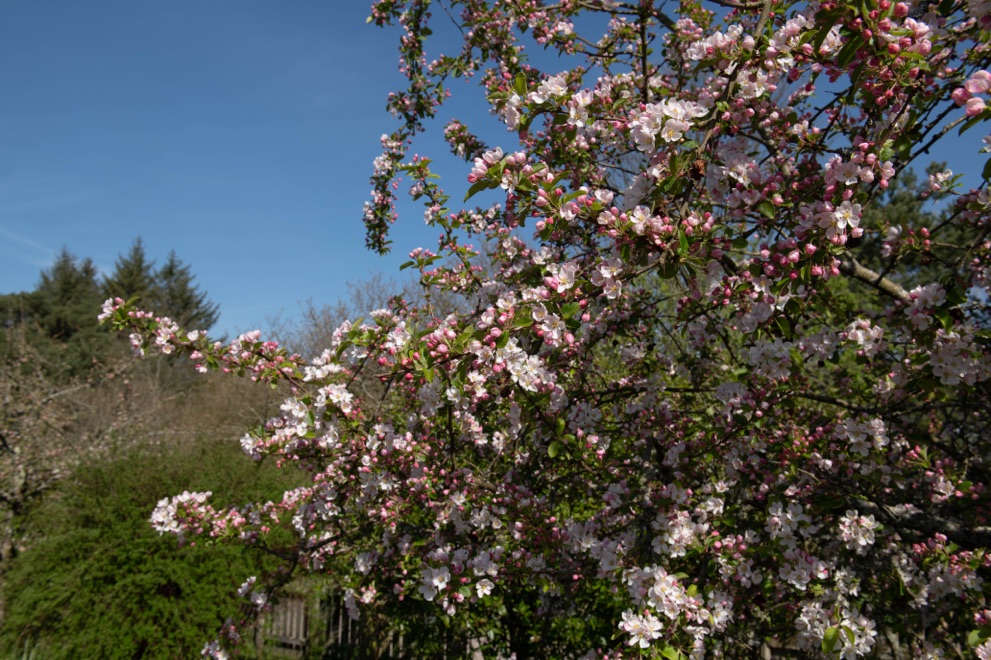
Crab apple trees tend to produce small to medium size fruits, which are often yellow, orange or red in colour depending on the variety.
The fruits can be rather unpalatable and tart when eaten raw, but they are perfect for making delicious jams, jellies and sauces.1Crab apple. (2022, May 30). BBC Good Food. Retrieved March 14, 2023, from https://www.bbcgoodfood.com/glossary/crab-apple-glossary
Most crab apple trees produce a wonderful, often scented blossom, with either pink or white flowers, which not only look stunning and signal the arrival of spring, but are loved by pollinators as well.

Crab apple trees are self-fertile and are sometimes planted near other apple trees or in orchards, as crab apples can pollinate other apples depending on their pollination group.
Long associated with love and fertility, crab apples are rich in symbolism and are sometimes known as ‘jewels of the countryside’, especially during winter when their fruits hang like gems amongst the bare branches.2Crab Apple (Malus sylvestris). (n.d.). Woodland Trust. Retrieved March 14, 2023, from https://www.woodlandtrust.org.uk/trees-woods-and-wildlife/british-trees/a-z-of-british-trees/crab-apple/
When used for burning they are often prized, as the wood gives off a sweet scent when burned.
“Planting a young crab apple tree bare root in winter will be inexpensive and give you instant blossom the following spring and decorative fruits in the autumn,” shares Garden Designer Non Morris.
Crab Apple Varieties
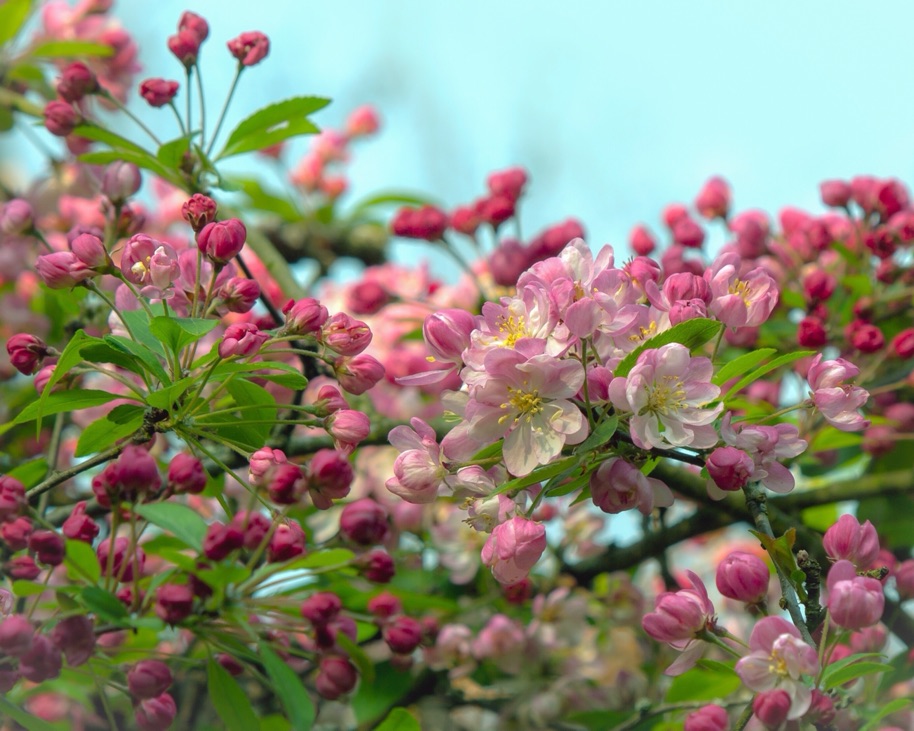
There are many different crab apple tree varieties that grow well here in the UK and can be found in various forms from half standards and weeping varieties to columnar habits.
With pale or dark blossoms, large or small fruits, for culinary purposes or purely ornamental, the choice is endless.
However, here are some of the most widely available varieties here in the UK.
Malus ‘John Downie’
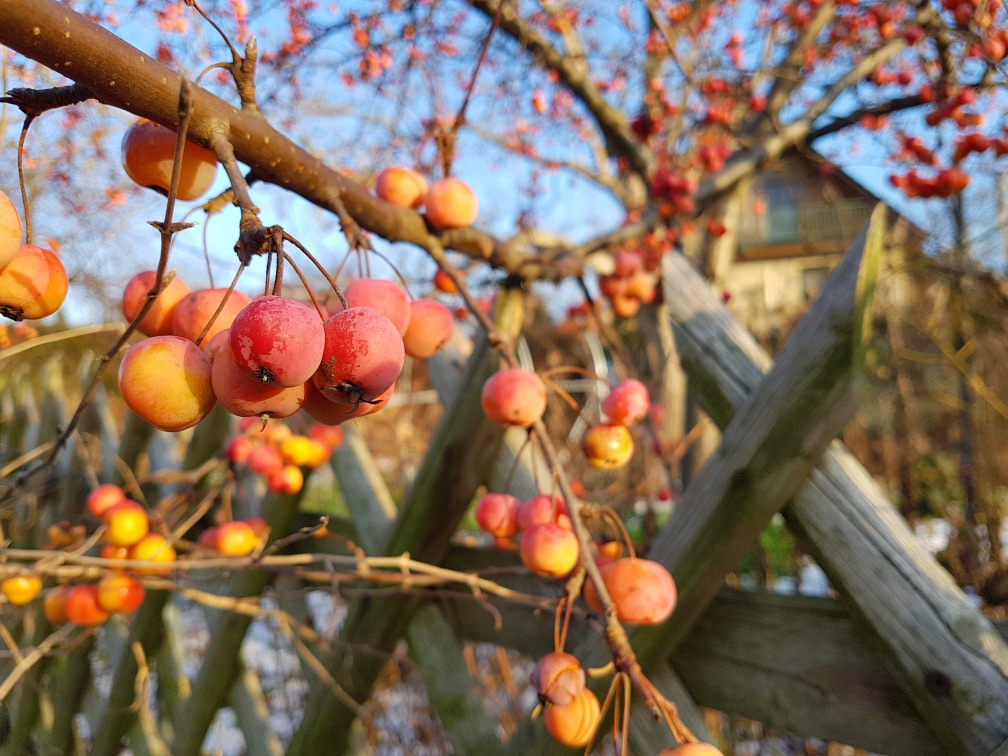
‘John Downie’ is a widely grown variety which will grow to an eventual 6m in height and 4m in spread over time.
It produces beautiful white flowers in spring and large orange fruits, perfect for making preserves.
Malus × atrosanguinea ‘Gorgeous’
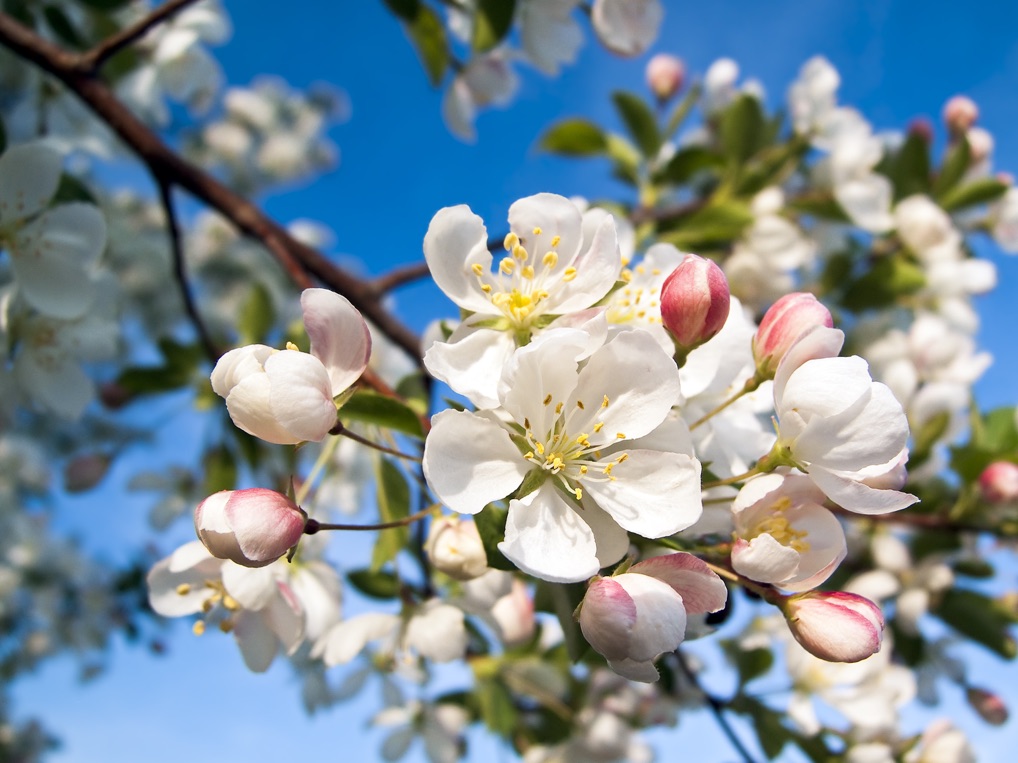
This ‘Gorgeous’ variety produces a lovely white blossom in spring and a heavy crop of red fruits, which stay on the tree right into winter and give some lovely winter interest to the garden.
Grows to an eventual height of 5m and spread about 4m wide.
“One of my favourite varieties is ‘Gorgeous’, which has large, glossy, bright, red fruits which remain on the tree until Christmas,” says Non.
Malus ‘Evereste’
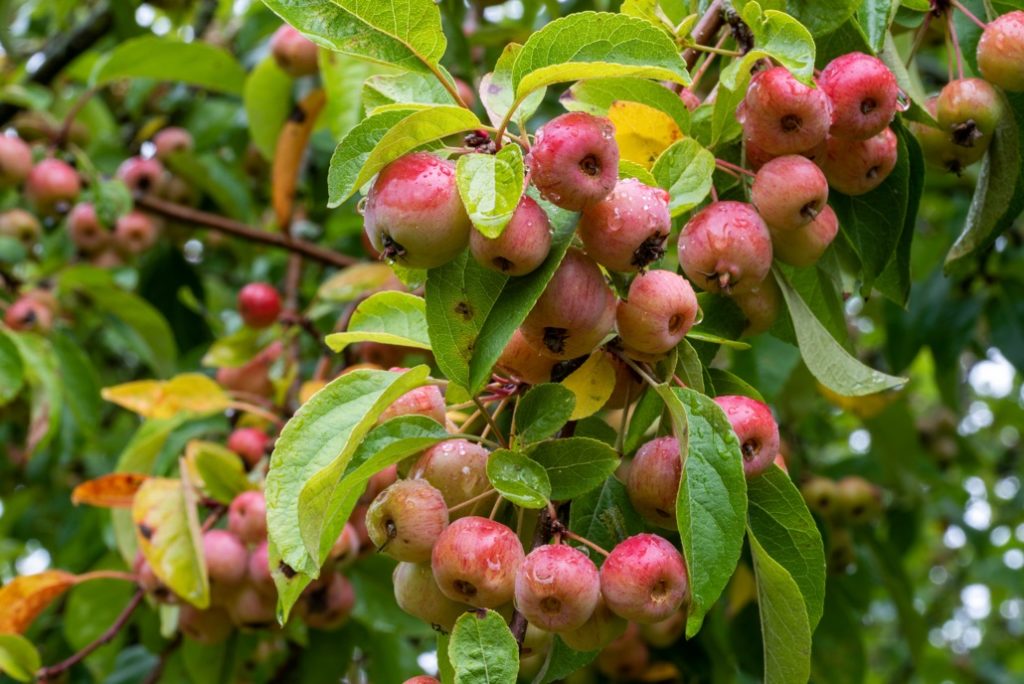
This variety can grow to up to 6m tall and 5m wide over time.
With its larger-than-average white flowers in spring, stunning fruit and more conical form, it is a great specimen to behold.
Having been awarded the RHS Award of Garden Merit (AGM) it has been shown to perform reliably well.3See RHS lists of top AGM garden-worthy plants, fruit & veg. (n.d.). Royal Horticultural Society. Retrieved May 15, 2023, from https://www.rhs.org.uk/plants/trials-awards/award-of-garden-merit/agm-lists
Malus ‘Comtesse de Paris’

‘Comtesse de Paris’ is a small tree growing to only 4m tall and 3m wide over time.
It displays a stunning white blossom following pink-tinged buds in spring and yellow fruits into the autumn.
Similar to Malus ‘Golden Hornet’, although with better disease resistance.4Malus “Golden Hornet.” (n.d.). Royal Horticultural Society. Retrieved March 14, 2023, from https://www.rhs.org.uk/plants/98350/malus-golden-hornet/details
Malus ‘Wisley Crab’

This variety is slightly different.
With its purple blossom in spring, it produces large and dark red fruits into autumn, which are great for making jellies.
When mature it can reach heights of up to 5m and a 4m spread.
How To Grow & Care For Crab Apples
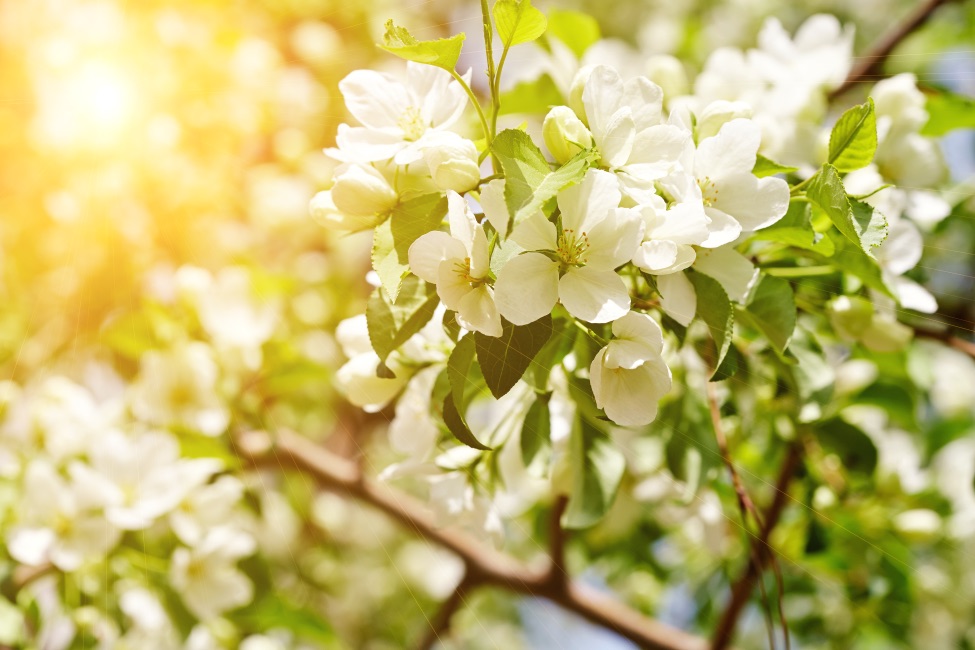
Crab apples tend to grow best in loamy soils, but will grow well in any moist, well-drained and fertile soil.
They are not a fussy tree to grow, but do dislike waterlogged ground, so it is best to grow them in free draining soil.
Crab apples can be grown in either full sun or partial shade and will cope with either a sheltered or exposed site.
However, they will certainly benefit with some shelter from the winds to protect the blossom and encourage pollination.
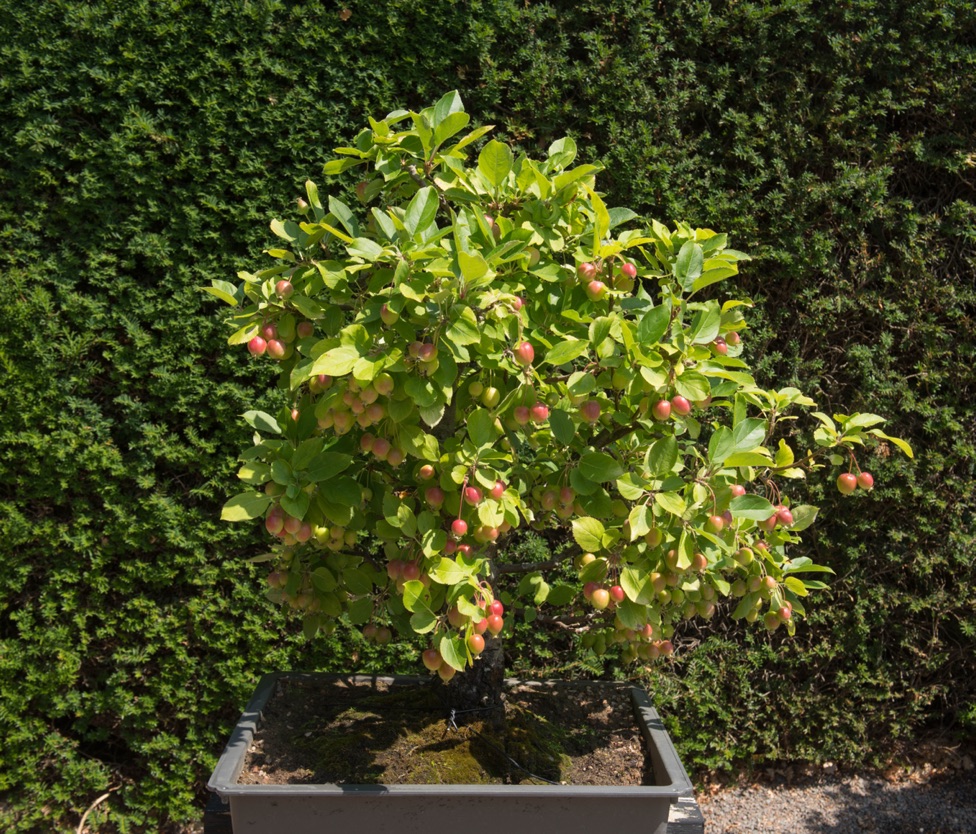
Crab apple trees can be bought either as potted throughout the year or as bare root from November until March.
Bare root trees should be planted quickly on arrival.
However, if this is not possible due to the ground being frozen or covered in snow, the tree can be stored somewhere cool with its roots wrapped in polythene (if purchased as a bare root tree) to stop them from drying out.
Planting
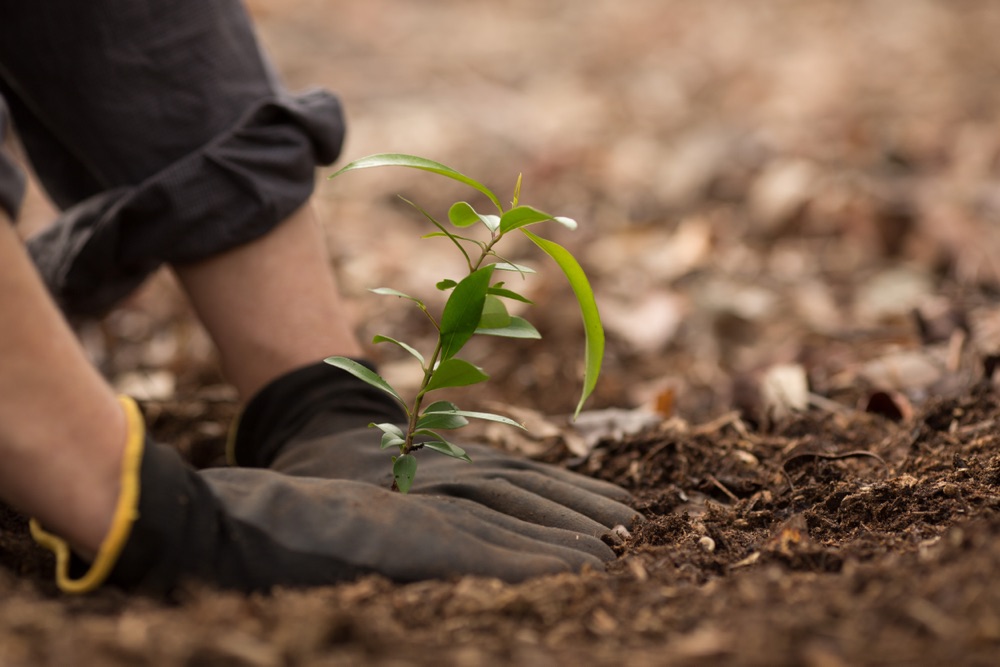
To plant a crab apple tree, dig a square hole twice as wide as the root ball or roots and at least as deep, loosening the soil at the sides and bottom of the hole.
Place a tree stake near to where the main stem will be and lower the tree into the hole to the same depth as it was previously planted.
Backfill with soil, gently firming the soil in around the roots to avoid any air pockets.
Water in well, attach the tree to the stake with a rubber tie and lay an organic mulch around the tree, which will help suppress weeds and conserve moisture.
Water well for the first few years, especially during hot and dry spells, until established, as Master Horticulturist Roy Nicol shares:
“A lack of watering is the most common reason for a tree to fail.
“Either tree irrigation bags or tree irrigation kits, where a plastic tube down to the tree’s roots is installed when planting, can be used to ensure a plentiful supply of water for the growing tree.”
Pruning
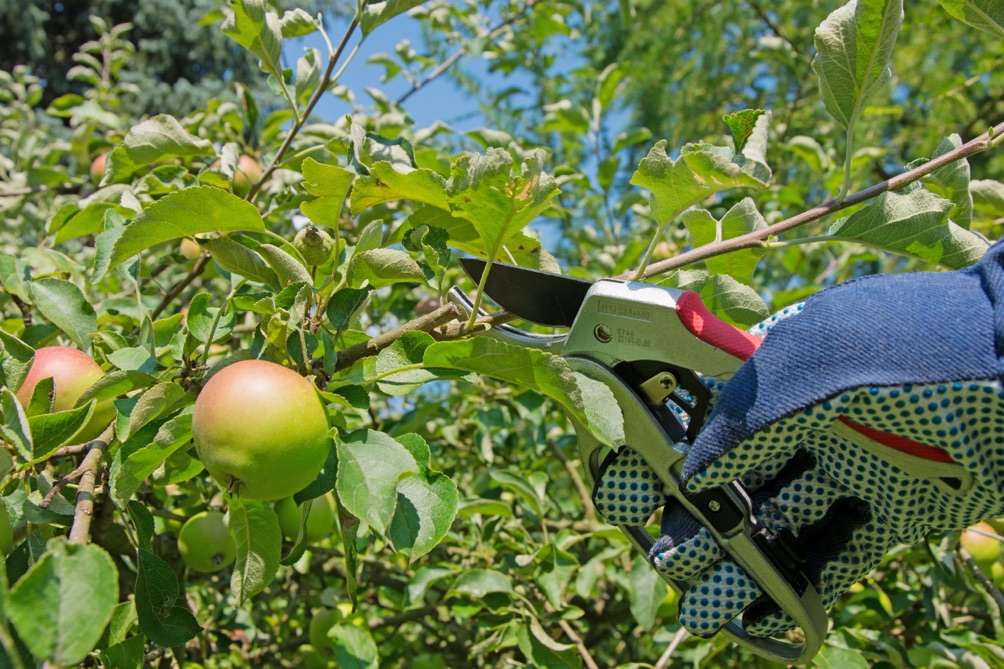
Crab apples belong to pruning group one and require formative pruning to encourage a good open shape to allow light and air in.
Most newly purchased trees will come with formative pruning instructions to follow, but guidance can be found online if required.
Once established, crab apple trees are similar to other apple trees and require annual pruning to remove any dead, diseased and crossing branches.
Common Problems
Scab
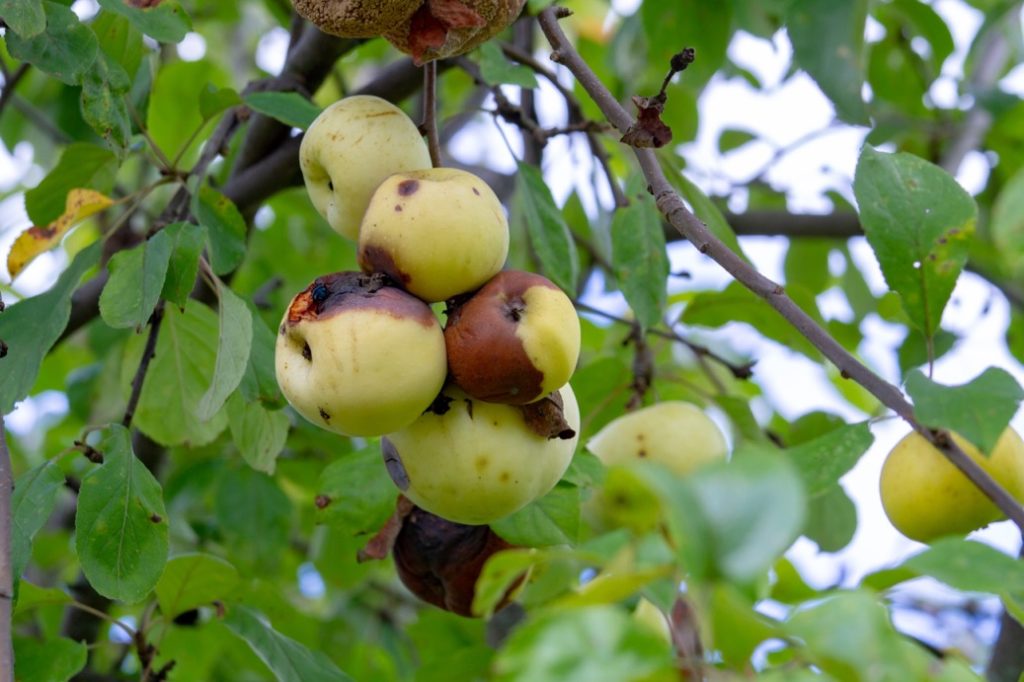
Crab apples are susceptible to a fungal disease called scab or Venturia inaequalis.
Scab spores are airborne and can even survive the winter, harbouring in fallen leaves.
Symptoms of scab often include brown scabby spots on the fruit, cracking on branches and twigs and green blotches on the foliage, which gradually become darker and often lead to the leaves falling prematurely.
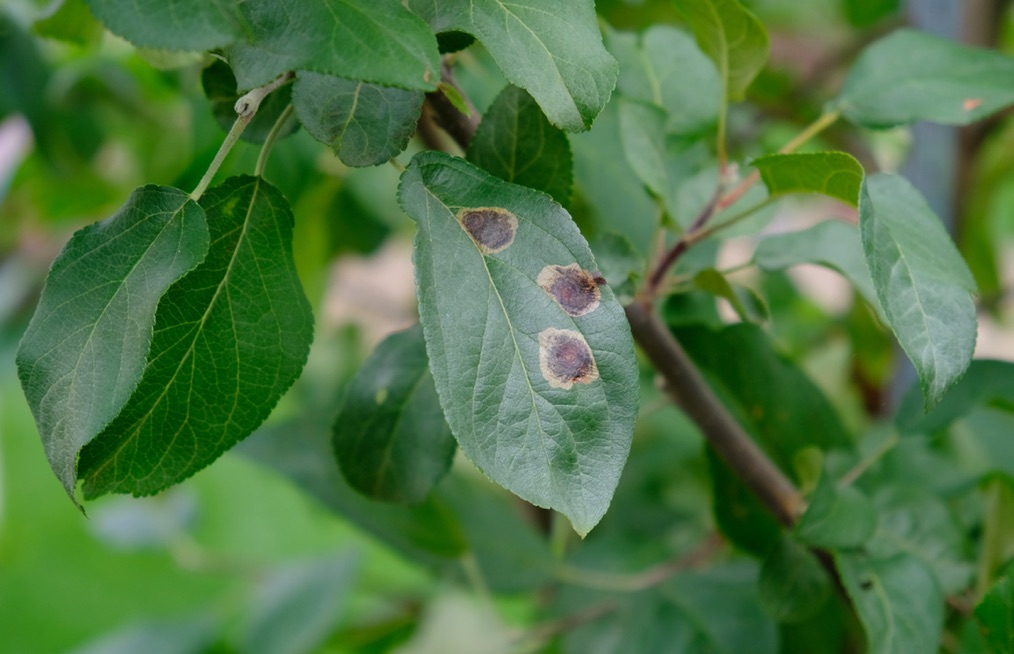
No chemical control is currently available for the home grower, so if scab is present swift action is recommended.
Cracked or blistered wood and fallen, infected leaves and fruit need to be removed in order to reduce the amount of fungus around for the following growing season.
Apple Canker
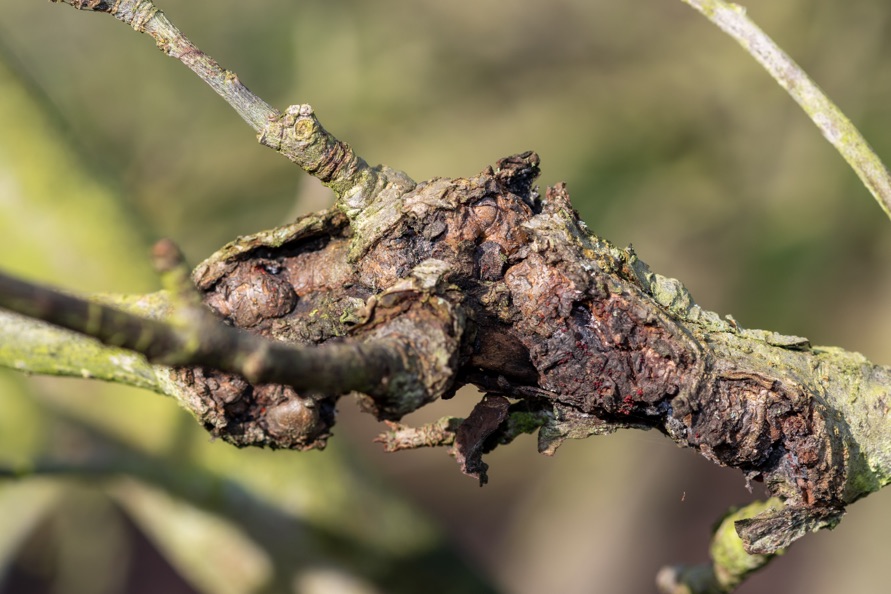
Canker is another fungal disease, Neonectria ditissima, that can affect apples, pears and some other species.
Apple canker affects the bark and wood of the tree, leading to the bark dying and eventual dead branches.
“Although certain varieties are more susceptible to canker than others, canker normally enters the tree via a wound of some kind, so care should be taken to avoid damaging the bark of the tree, which is easily done when pruning,” shares Roy.
Cankers tend to appear in spring with the bark dying and eventually falling off, leaving the dead wood of the inner tree exposed and leading to the wood above the canker dying.
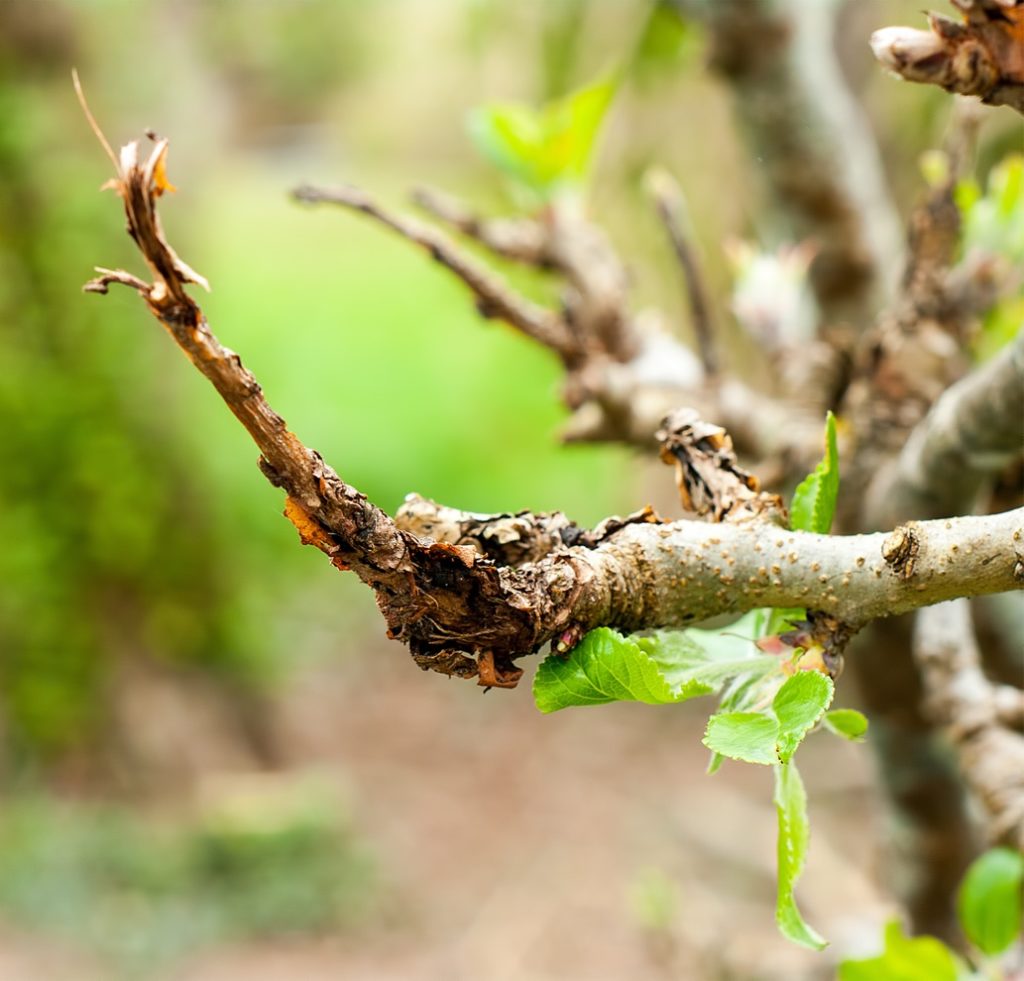
There is sadly no chemical control for canker.
If canker is spotted, the advice is to cut off any affected smaller branches or twigs and cut the canker out of larger branches removing all diseased bark and wood.
“It’s very important to sterilise tools after this as the fungal infection can be carried to the next tree being pruned,” adds Roy.
The wounds can then be painted with a wound-healing paint that will hopefully prohibit any reinfection to the wound.
Fireblight
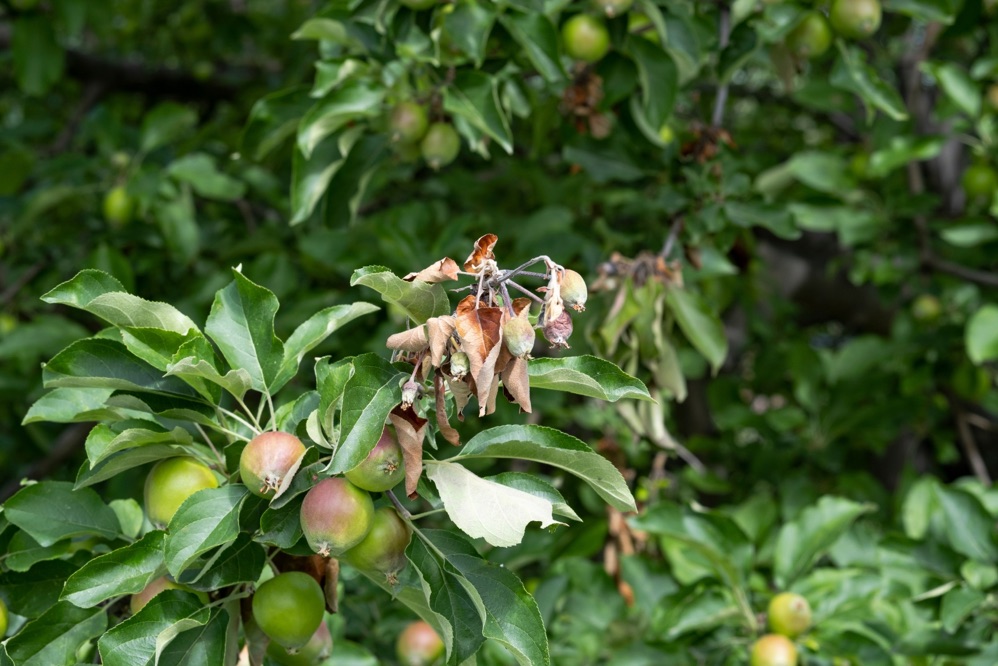
Fireblight was first discovered in the UK in the 1950s and is a bacterial disease that looks as though the leaves and twigs have been scorched, hence its name.5Erwinia amylovora (fireblight). (2022, January 7). CABI Compendium. https://doi.org/10.1079/cabicompendium.21908
Fireblight usually affects apple, pear and other ornamental trees in the Rosaceae family from spring through until autumn.
Caused by the Erwinia amylovora bacteria, symptoms can include scorched-looking shoots, cankers appearing and flowers dying at the time when they should be in bloom.
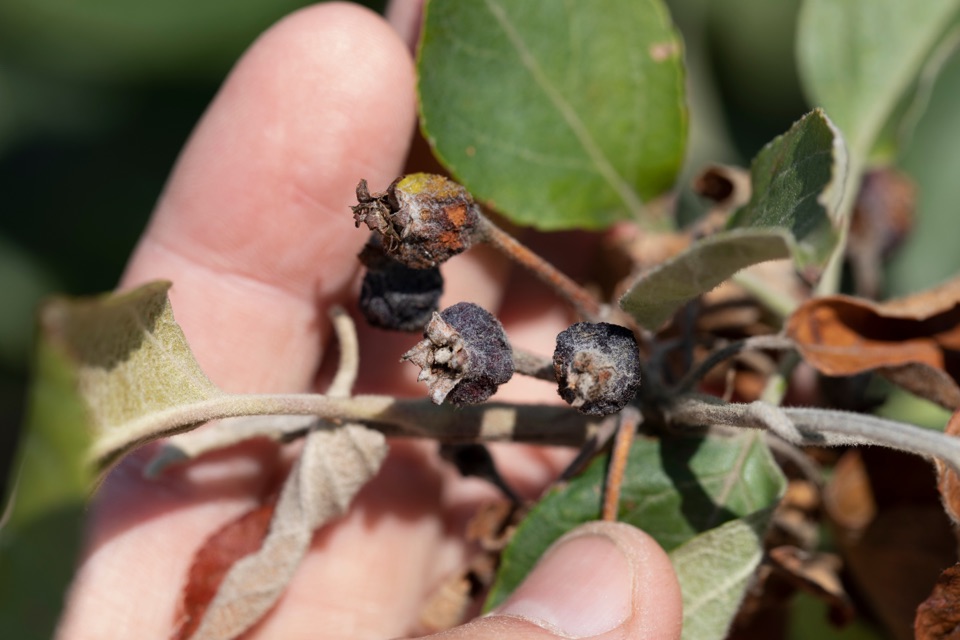
As with canker, there is no chemical control available.
Instead, if fireblight is spotted it is recommended to act swiftly, as fireblight spreads rapidly and to cut off any infected material and some way back into healthy wood.
Again, it is important to not compost any affected prunings and disinfect any tools used.
References
- 1Crab apple. (2022, May 30). BBC Good Food. Retrieved March 14, 2023, from https://www.bbcgoodfood.com/glossary/crab-apple-glossary
- 2Crab Apple (Malus sylvestris). (n.d.). Woodland Trust. Retrieved March 14, 2023, from https://www.woodlandtrust.org.uk/trees-woods-and-wildlife/british-trees/a-z-of-british-trees/crab-apple/
- 3See RHS lists of top AGM garden-worthy plants, fruit & veg. (n.d.). Royal Horticultural Society. Retrieved May 15, 2023, from https://www.rhs.org.uk/plants/trials-awards/award-of-garden-merit/agm-lists
- 4Malus “Golden Hornet.” (n.d.). Royal Horticultural Society. Retrieved March 14, 2023, from https://www.rhs.org.uk/plants/98350/malus-golden-hornet/details
- 5Erwinia amylovora (fireblight). (2022, January 7). CABI Compendium. https://doi.org/10.1079/cabicompendium.21908
